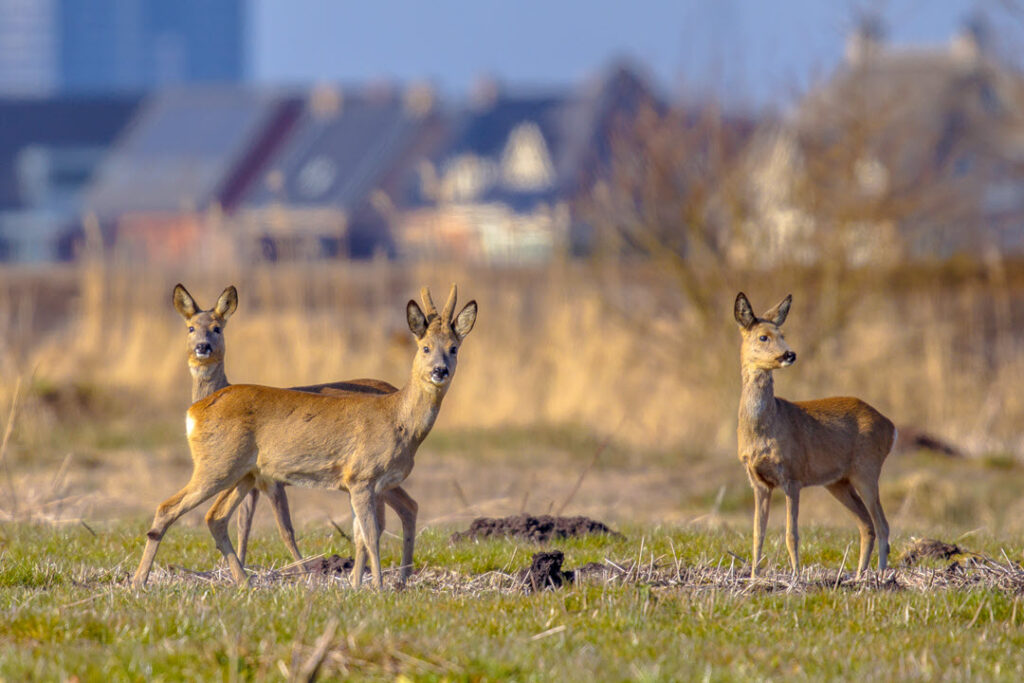Deer in Urban Areas
Share article:
Article by:
Charles Smith-Jones, Technical Adviser, British Deer Society
Deer in Urban Areas
Deer are regularly reported in urban gardens or housing estates and members of the public often wonder if there is any action that they ought to take.
In most cases, there is no need to do anything. The species most regularly encountered in built-up areas tend to be roe or muntjac. Both are small and generally solitary and are often content to live in close proximity to humans as they remain relatively undisturbed and have appropriate food and cover available.
Deer are usually anxious to avoid contact with humans and it is highly unusual for one to act aggressively towards them so they present no particular danger to people in the vicinity.
Deterring Deer
Though they are often welcome garden visitors, not everyone appreciates the attention that deer can pay to prized flower beds and vegetable patches. In such cases, the only truly effective way to prevent them from visiting is a properly constructed fence (deer usually easily bypass normal boundaries or stock fences by jumping over or creeping under them).
Fencing can be an expensive undertaking, may be unsightly and may not be an option for larger areas. The height and mesh size necessary would depend on the species visiting the garden.
It is essential that fences are strongly constructed, properly tensioned and either dug in (recommended) or folded and turfed over on the outside to prevent deer from finding a way underneath.
They need to be robust enough to stop an animal from entangling legs, antlers or body, with a sufficient gauge of mesh to prevent the animal from squeezing through; if the head fits, the body can often follow.
Flimsy materials, such as chicken wire, light plastic or nylon mesh should be avoided.
Depending on circumstances, it might also be possible to persuade the deer to avoid the area and not return by making it less attractive to them.
The BDS website provides suggestions for fence design and potential deterrents as well as options for protecting plants.
Exploiting Small Gaps
All deer can be adept at exploiting surprisingly small gaps. Even when they appear to be ‘trapped’ in a fenced garden they generally find their way out when they are ready, and it is very possible that any animals seen may already be coming and going at will using well-established access points.
Deer usually simply move on if they find that their environment becomes too inhospitable but occasionally one might become genuinely trapped within an enclosed area.
If it is possible to leave a gate open or to raise the bottom of a fence by a few inches, this will be helpful to the deer. Narrow creep ways under fences need only be a few inches high to let a muntjac or roe through (if the head fits through, they can flatten their bodies sufficiently to follow in most cases).
The immediate area should be left as undisturbed as possible to encourage an unhurried departure and most movement will probably be during the hours of darkness.
It is possible that the deer may already be travelling widely within the local area; roads do not seem to deter them, especially during times when traffic is light.
Relocating Trapped Deer
If a deer does appear to be genuinely unable to escape an enclosed area, on no account should attempts be made to shoo it out as the animal will inevitably panic and may injure itself.
While anaesthetic darting or capture are possibilities, such an approach will inevitably be stressful to the deer and must be conducted by a skilled operator, is subject to strict legal constraints and licenses, and is not recommended except as a very last resort.
It is also important to point out that, under existing law, any muntjac taken into captivity can never be released into the wild again.
If you feel that direct action does need to be taken, or if a deer is showing any signs of distress or injury, you should consider contacting the RSPCA or a wildlife rescue organisation that should be able to assist or at least recommend a suitable alternative.
Additional Advice
By clicking on the following links you can find further advice on what to do if you encounter a dead, injured or entangled deer, or if you are present at a deer-vehicle collision.
Deer can easily become confused and panicked if unduly stressed. If you are concerned that one might pose a threat to public safety, perhaps by running around on busy roads or having inadvertently entered a building, it might be appropriate to inform the police using the emergency 999 number or 101 for non-emergencies.
Otherwise, local councils or road authorities may be prepared to erect wildlife warning signs in places where high levels of deer activity might expose them to regular contact with traffic if advised of the dangers they pose to drivers and themselves.
All reports of deer presence are welcomed by the BDS. This is easily done using our free Deer App or by sending an email to info@bds.org.uk including your location, brief details and a photograph if possible.
Please help us continue to speak up for deer by donating using the box below.












